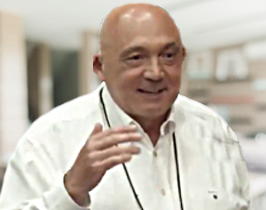 Título da palestra: Semiconductores inorgánicos como catalizadores avanzados
Título da palestra: Semiconductores inorgánicos como catalizadores avanzados
Resumo do palestrante: Professor Juan Andrés has been a post-doctoral researcher at Uppsala University, Sweden(1984-1990); and a Visiting professor at both Pierre et Marie Curie University, Paris (1998 and 2000) and Centro de Desenvolvimento de Materiais Funcionais (CDMF), Brazil (2007 and 2014). On returning from the postdoctoral stay at the University of Uppsala, he decided to start a project aimed at developing and applying quantum mechanics in order to understand the structure and chemical reactivity in homogeneous, heterogeneous and enzymatic catalysis. Nobody in Spain (and only few people in Europe and the US) was working on that topic, which could fit into the field of “Theoretical and Computational Chemistry” (QTC).
In 1991 Juan Andrés founded at UJI, the “Theoretical and Computational Chemistry” (QTC) Laboratory. In 2000, QTC Laboratory reached the consideration of Center of Excellence Marie-Curie within Improving Human Research Potential and the Socio-Economic Knowledge Base (Research funding of the European Union; project IHP-MCHD-99-1; 2000-2004). Several years of hard work eventually allowed us to obtain good results, which were published as scientific articles in general chemistry journals (sixteen JACS, two Chemical Society Reviews, two Angewandte Chemie, six Chemistry – A European Journal), and in prominent specific journals on physics and chemistry. These articles were the first ones addressing this area of knowledge to be published in Spain, which allowed us to achieve new projects, consolidate this line of research and generate new results. In addition to this line of research, we started working in parallel on materials science and nanotechnology, and we managed and developed R&D&I projects in collaboration with universities in Spain, Sweden, France, Chile, and Mexico, as well as a close collaboration with the CDMF in Brazil. Consequently, the productivity of the QTC grew significantly with works devoted to understanding the chemical structure and the reaction mechanism, and to reaching a deep insight of the properties, on the atomic scale, that determine the macroscopic behaviour of micro- and nanomaterials.
While being QTC’s director, more than 175 researchers and technologists from over twenty countries were trained, 30 of whom obtained a doctoral degree under its direct supervision. Today, 12 of them are Full Professors and 20 of them are Senior Lecturers at universities in Europe and South America. More than 60 of them work as researchers both at universities and R&D&I centres or hold significant positions in different industries in over 20 countries. 5 of them have set up technology-based companies.This led to the publication of numerous scientific articles in high-index international journals. Since 2005, he has published more than 280 articles in leading international journals.
The work carried out by the QTC has enabled us to produce new materials with properties that have been modulated for technological applications, such as gas sensors, photocatalysts and materials containing silver nanoparticles with very powerful bactericidal and antifungal properties, synthesised by electron and/or laser irradiation. These results have, in turn, led to the creation and consolidation of three spin-offs and start-ups.


